Debt Relief If you’re struggling to make progress despite your best efforts, it may be time to explore relief options and regain financial control.
Debt relief options can help you pay off your debt or make it easier to repay, such as negotiating directly with creditors, enrolling in a debt management plan, or declaring bankruptcy.
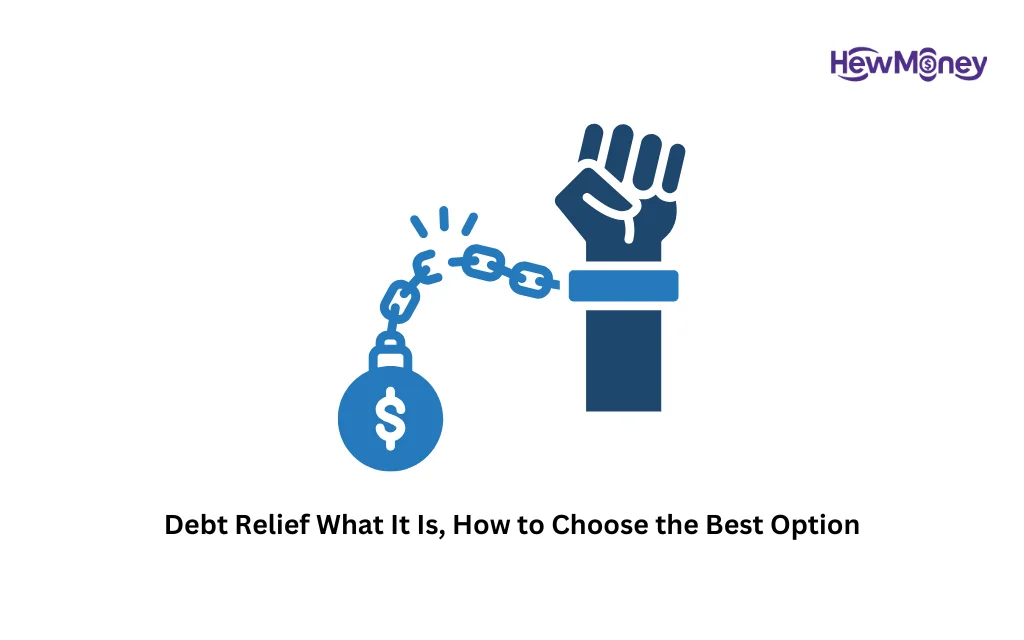
What is debt relief?
Although the word “debt relief” can refer to a variety of things, the primary objective of any debt relief program is often to modify the terms or amount of your debt in order to help you get back on your feet more quickly.
Debt relief may entail:
- settling the debt for less than the entire amount owing by negotiating with creditors.
- declaring bankruptcy and completely wiping the debt.
- requesting adjustments to your interest rate or payment schedule through a debt management plan.
When should you seek debt relief?
If any of these apply to you, think about debt management, bankruptcy, or do-it-yourself debt relief:
- Even if you make drastic expenditure cuts, you have no chance of paying back unsecured debt (credit cards, medical bills, and personal loans) within five years.
- You owe half or more of your gross income in unpaid unsecured debt (not including student loan debt).
What are the debt relief options to consider?
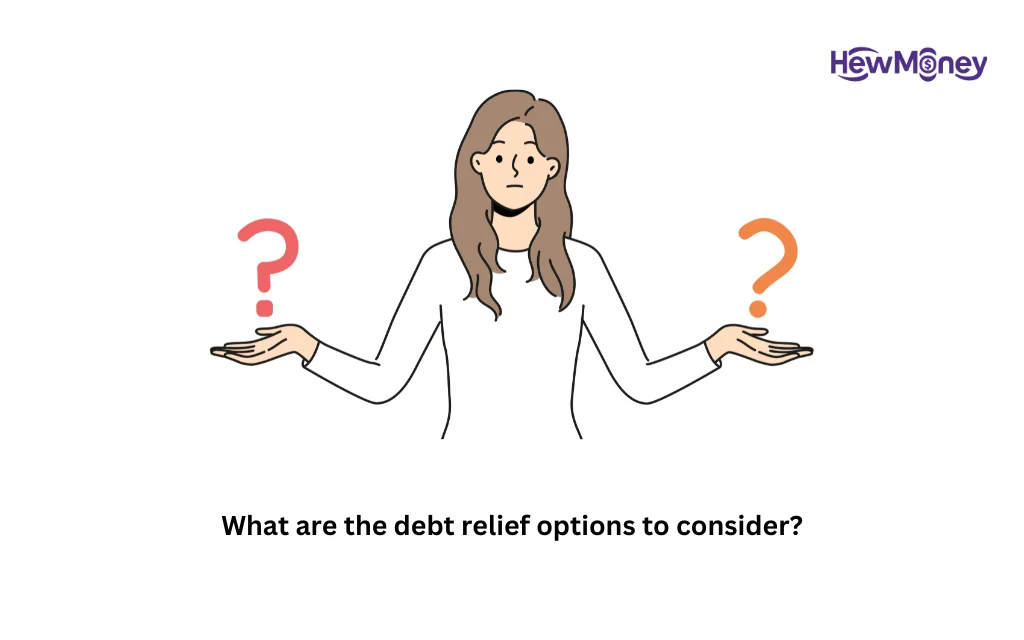
Do-it-yourself debt relief
By combining more stringent budgeting, credit counseling, debt consolidation, and creditor appeals, you can manage debt independently without enrolling in an official debt-relief program.
For instance, you can follow the steps taken by credit counselors in debt management programs: Speak with your creditors and let them know why you fell behind and what you need to give up to make up the difference. Under their hardship programs, the majority of credit card firms might be ready to eliminate fees and reduce your interest rates.
Additionally, you might contact creditors to negotiate a deal and educate yourself about debt settlement.
Standard debt-payoff solutions might be available if your debt is not too big. For instance, you might be eligible for a credit card with 0% balance transfers, contingent on your credit score.
This entails switching your debt from a credit card with a higher interest rate to one that has an initial annual percentage rate (APR) of 0%. Your entire payment is used to lower the balance during the interest-free period, accelerating the process. Alternatively, you can discover a debt consolidation loan that has a cheaper interest rate than what you currently pay.
Your credit score should rise as long as you complete the payments by the conclusion of the promotional period, so such options will not harm it. However, if you choose this path, you need have a strategy in place to prevent accruing additional credit card debt.
Debt management plans
You can pay off your unsecured debts, which are usually credit cards, in full with a debt management plan, but frequently with a lower interest rate or no fees. A credit counseling organization receives your monthly payment and divides it among your creditors. Credit card issuers and credit counselors have agreements in place to assist customers with debt management.
You will often have to live without credit cards until the plan is finished, and your credit card accounts will be closed.
Closing accounts can lower your credit ratings, but debt management methods have no effect. You can reapply for credit after completing the plan.
However, you risk being kicked out of the plan if you miss payments. Additionally, choosing a company that has been accredited by the Financial Counseling Association of America or the National Foundation for Credit Counseling is crucial.
As usual, be careful to comprehend the costs and the options available to you for handling debt.
Debt relief through bankruptcy
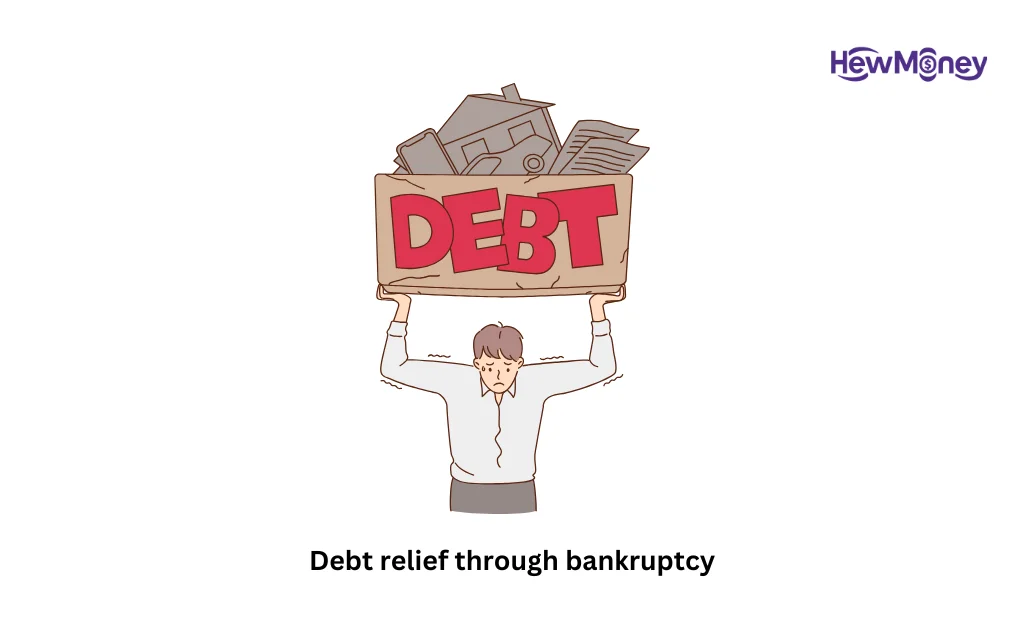
Entering a debt management plan is pointless if you can not make the agreed-upon payments. Consult a bankruptcy lawyer first. Free initial consultations are frequently offered, and you can explore other possibilities if you are not eligible.
Bankruptcy under Chapter 7
The majority of credit card debt, unsecured personal loans, and medical debt can be eliminated through Chapter 7 liquidation, the most popular type of bankruptcy. If you are eligible, it can be completed in three or four months. Things to be aware of:
Child support requirements will not be eliminated.
- It will remain on your credit report for up to ten years and lower your credit ratings.
- However, filing for bankruptcy can enable you to repair your credit far more quickly than if you continue to struggle with repayment.
- If you filed for bankruptcy with a co-signer, that person will be held entirely liable for the loan.
- You will not be able to file for Chapter 7 bankruptcy again for eight years if your obligations keep mounting.
- If you would have to give up property you would like to keep, it might not be the best choice. States have different regulations. Generally speaking, several types of property are shielded from bankruptcy, including cars up to a specific value and a portion of your home’s equity.
- If you do not have any assets or income that a creditor could seize, it might not be required.
Chapter 13 bankruptcy
Not all people who have a lot of debt are eligible for Chapter 7. You might need to apply for Chapter 13 bankruptcy if your family size and state median income are higher than average, or if you have a house you wish to keep from going into foreclosure.
Chapter 13 is a court-approved repayment plan that lasts either three or five years, depending on your obligations and income. The remaining unsecured debt is forgiven if you can continue with the plan for the duration of its term.
You will keep your property if you can make your payments on time, which most people can’t. After the date of filing, a Chapter 13 bankruptcy remains on your credit report for seven years.
Debt settlement: A risky option
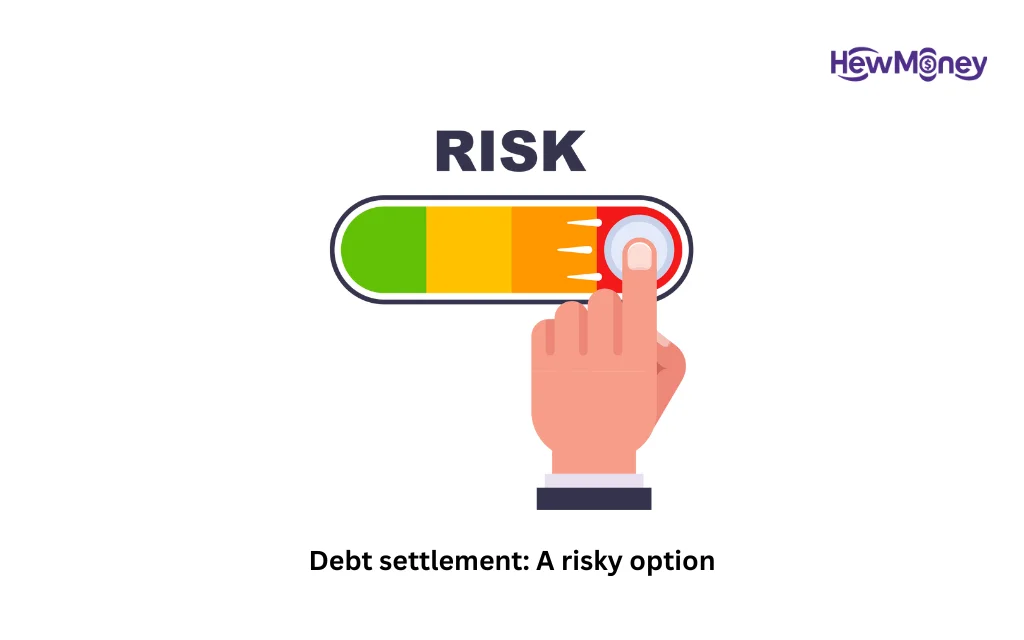
For people who have excessive debt but are ineligible for bankruptcy or do not choose to file for bankruptcy, debt settlement is a final choice.
According to the Consumer Financial Protection Bureau, when you sign up for a settlement plan, debt settlement agencies usually urge you to stop making debt payments and instead place the funds in an escrow account.
As the funds build up in your account and your payment arrears worsen, you are contacted by each creditor. The creditor may accept a smaller lump-sum offer and agree not to pursue you for the remaining amount out of fear of receiving nothing at all.
Why this option is risky
Due to late fees, interest, and other credit card debt-related expenses, you may wind up with debts that are even larger than you initially had [1].
You may face collection calls, penalties, and even legal action if you do not pay your payments. Property liens and wage garnishments may result from lawsuits. While you are still discussing, debt settlement does not stop any of it, and the start of settlement offers may take months.
You can potentially receive a tax charge for the forgiven sums (which the IRS considers income) if your debt is settled.
The Federal Trade Commission, the CFPB, and the National Consumer Law Center all strongly warn consumers about the unethical actors that abound in the debt settlement industry.
Additionally, some debt settlement firms market themselves as debt consolidation firms. They are not. You may conduct debt consolidation on your own, and it will not harm your credit.
Debt relief scams to watch out for
You might be able to start over and make significant progress with debt reduction. However, be advised that scammers may attempt to steal your meager funds from the debt relief sector [2].
Before signing a contract with a debt settlement provider, make sure you comprehend and confirm the following:
- What you need to qualify.
- What charges you will incur.
- How much is being paid to which creditors? Make sure you know who owns your debt if it is in collections so that payments are made to the appropriate party.
- the consequences for taxes.
- if the business you select cooperates with your debtors.
Steer clear of debt relief plans that make any of the following claims:
- need payment of a charge prior to the settlement of your debt.
- Promise to pay off your debt at a “too good to be true” price.
- reassure you that it can prevent any debt collecting calls and litigation .
Debt relief options to avoid
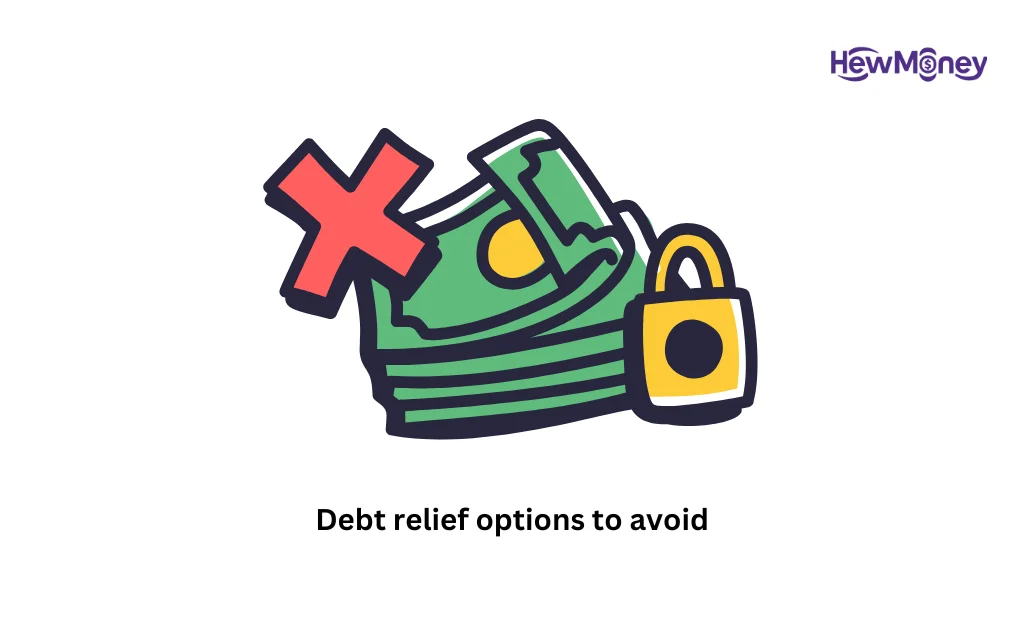
Overwhelming debt can occasionally be accompanied by catastrophic events like a natural disaster, job loss, or health problem. Or perhaps it happened gradually, and now when collection agencies and creditors are putting pressure on you to make payments, you just are not able to.
Here are some things to try to avoid if you are feeling overburdened by debt:
- Paying off an unsecured debt (such as a credit card or medical bill) should not come at the expense of a secured debt (such as a car payment). Your car, which serves as
- collateral for that obligation, could be taken away from you.
- Avoid taking out a loan against your home’s equity. You may be converting unsecured debt that could be discharged in bankruptcy into secured debt that cannot, and you are placing your house at risk of foreclosure.
- If at all possible, avoid taking out a loan from your employer retirement plan. The loans may become unintentional withdrawals and result in a tax bill if you lose your employment.
- Do not base your choices on which collectors are putting the most pressure on you. Rather, spend some time investigating your options and selecting the most appropriate one for your circumstances.

